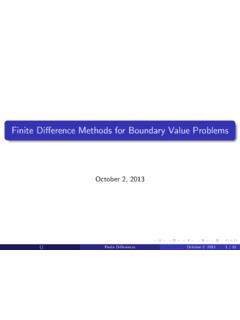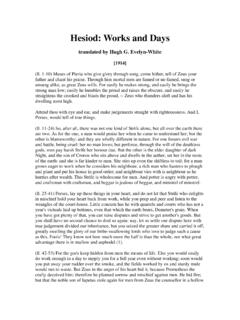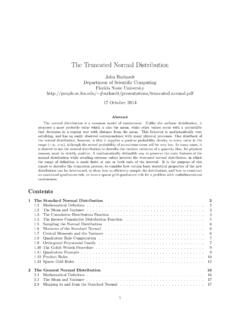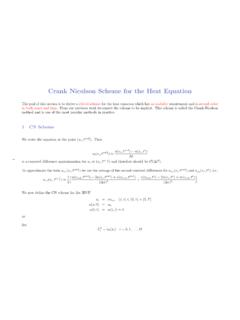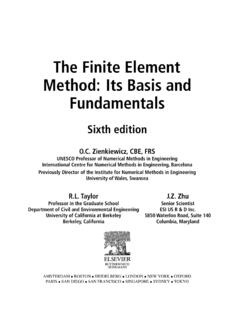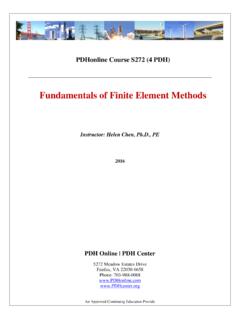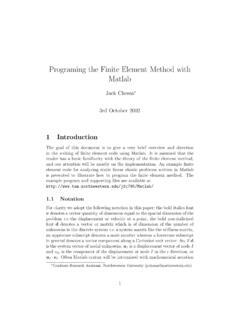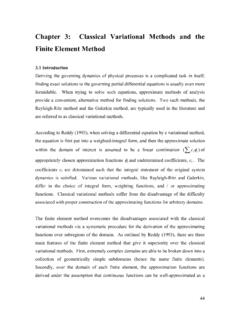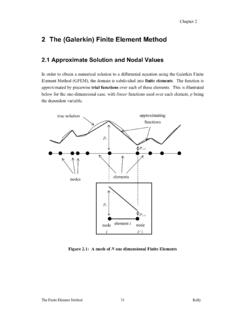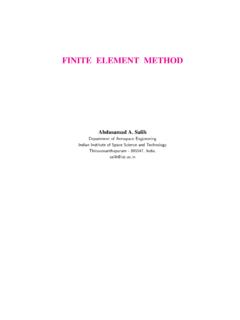Transcription of Meshing for the Finite Element Method
1 Meshing for the Finite Element MethodISC 5939: Advanced Graduate BurkardtDepartment of Scientific ComputingFlorida State jburkardt/classes/fem2011/.. November 20111 / 1 FEM MeshingMeshing as Part of FEMC omputer RepresentationsThe Delaunay TriangulationDISTMESHMESH2 DStoring a Mesh as a FileConclusion2 / 1 Meshing :The name Finite Element Method is meant to suggest thetechnique we apply to all problems. That is, we look at thegeometry, the shape of a region, and immediately imagine itbroken down into idea is that we are going to use a simple approximationmethod, but the errors in this approximation Method becomeunnoticeable as the size of the subregion gets small.
2 So if we useenough small subregions, approximate over each one, and thenstitch all the answers back together, we can get as smooth andbelieveable an answer to our original full size problem as we we are trying to predict the temperature on a metal plate, wemight be able to get away with assuming that temperature islinear, or perhaps even constant, as long as the subregions aresmall / 1 Meshing :Thus, even though the hard part of the Finite Element methodinvolves considering abstract approximation spaces, sequences ofapproximating functions, the issue of boundary conditions, weakforms and so on, it all starts with a very simple idea:Take a geometric shape, and break it into smaller, simpler shapes,in such a way that we can put it all back together when we re this is such a simple idea, you might think there s no reasonto worry about it much!
3 4 / 1 Meshing :Indeed, if we start by thinking of a 1D problem, such asmodeling the temperature along a thin strand of wire that extendsfromAtoB, our Meshing problem is trivial:ChooseN, the number of subregions or elements ;InsertN-1equally spacednodesbetweenAandB;CreateNelements, the intervals between successive this problem, we can write down formulas for the location ofeach node, the location of each Element , the indices of the pair ofnodesIandJthat form elementK, and the indices of theelementsLandMthat are immediate neighbors to / 1 Meshing : Nodes and elements in 1D6 / 1 Meshing : Nodes and elements in 1 DIt might seem that the 2D world is going to be just as easy!
4 Wejust take our rectangular region, defined by four corners, placenodes along each side and then put nodes at intersection points,and then, because we prefer triangles, we split each of the resultingsquares into two triangular , we can write down, fairly easily, the location of every node,the nodes that form each triangle, and the triangles that neighboreach / 1 Meshing : The ELL ProblemFor our basic 2D example, we ll consider an L-shaped region,and show how to go through the basic Meshing it s time to talk about programs for doing the Meshing forus, we will come back to this same problem, so keep its simpleshape in mind!
5 It s simply a square of dimension 2x2 units, from which a 1x1 unitsquare in the northeast has been / 1 Meshing : Nodes and elements in 2D9 / 1 Meshing : Nodes and elements in 2D10 / 1 Meshing : Nodes and elements in 2D11 / 1 Meshing : Rectangular Regions Are Not Good Enough!While a mathematician or academic computing person mightregard our L-shaped region as wildly irregular, a person whoactually needs to use the Finite Element Method will regard the useof purely rectangular regions as unrealistic and much too limited tobe s similar to trying to analyze a horse race by starting out withthe assumption All horses can be regarded as perfect spheres.
6 Well, what kind of problems do we really need to be able to solve?12 / 1 Meshing : We Want Small elements Near Boundaries!We need to be able to use meshes that smoothly change in sizenear the boundary, where we expect the solution to change a / 1 Meshing : We May Need Transition Zones!We need the mesh to be able to get small near sensitive spots .14 / 1 Meshing : We Want to Handle Holes (and Surfaces)!We need to be able to place a mesh on a surface that includesholes and / 1 Meshing : On a Surface, We Must Match Curvature!
7 The mesh must be able to adapt to local features (in this 3 Dcase, curvature.)16 / 1 Meshing : Realistic Problems Can t Be Meshed by Hand!The regions I have shown you are more complicated and realisticthan the simple rectangles we started with. Surely the results willbe fabulous. But who is going to do the grunt work of setting theproblem up?In other words, given nothing but the shape of the region, andpossible some warnings about holes, edges, sensitive spots, or anidea about where the mesh must be small and where it can becoarse, how do I:describe the input information to a computer?
8 Use the input information to choose nodes?use the nodes to construct elements ?construct all the arrays of connectivity information?It is not uncommon to ask for 1,000,000 nodes. Clearly, we aregoing to need help!17 / 1 FEM MeshingMeshing as Part of FEMC omputer RepresentationsThe Delaunay TriangulationDISTMESHMESH2 DStoring a Mesh as a FileConclusion18 / 1 REP: Data and Files for MeshesThe objects we are talking about must somehow be representedon a computer. It may be helpful to go over how these objectsmight be represented, and in some cases, suggest how one objectcan be computed from fundamental object, of course, is the region.
9 Let s keep thingssimple and assume we re simply dealing with a subset of the plane,such as a circle, square, perhaps an irregular polygon, or possiblean arbitrary curvy closed region might have sharp corners, stretches with a fixedcurvature, interior holes or barriers. In the most general case, thisis a hard object to / 1 REP: Define a Region by Boundary VerticesWe will assume that the region can be defined by one or moreclosed curves, approximated using straight line segments. Even ifour region is a circle, we specify it by a sequence of straight circle might be specified by 24 evenly spaced region is really specified by the curve suggested by the vertices,so we should be more careful and either insist that the 24 verticesare connected one after another, or else we should include anadditional set of information, namely, the order in which the givenvertices should be connected to bound the advantage of the second approach is that.
10 If I always specifysuch a curve in counterclockwise order, then it is easy to describeregions with multiple parts, or with / 1 REP: Define a Region That is a Square Minus a TriangleHere is a region defined by a square with a triangular V: { (0,0), (5,0), (5,5), (0,5),(4,2), (2,1), (2,4) }Boundary Indices BI: { 1, 2, 3, 4, 1, 5, 6, 7, 5 }This describes a square from which a triangle has been region is on the inside of both curves, that is, points that lieon the left hand side as you follow each could plot this data by starting with the first index (andremembering it!)
